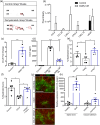Low sulfated heparan sulfate mimetic differentially affects repair in immune-mediated and toxin-induced experimental models of demyelination
- PMID: 36945189
- PMCID: PMC10952530
- DOI: 10.1002/glia.24363
Low sulfated heparan sulfate mimetic differentially affects repair in immune-mediated and toxin-induced experimental models of demyelination
Abstract
There is an urgent need for therapies that target the multicellular pathology of central nervous system (CNS) disease. Modified, nonanticoagulant heparins mimic the heparan sulfate glycan family and are known regulators of multiple cellular processes. In vitro studies have demonstrated that low sulfated modified heparin mimetics (LS-mHeps) drive repair after CNS demyelination. Herein, we test LS-mHep7 (an in vitro lead compound) in experimental autoimmune encephalomyelitis (EAE) and cuprizone-induced demyelination. In EAE, LS-mHep7 treatment resulted in faster recovery and rapidly reduced inflammation which was accompanied by restoration of animal weight. LS-mHep7 treatment had no effect on remyelination or on OLIG2 positive oligodendrocyte numbers within the corpus callosum in the cuprizone model. Further in vitro investigation confirmed that LS-mHep7 likely mediates its pro-repair effect in the EAE model by sequestering inflammatory cytokines, such as CCL5 which are upregulated during immune-mediated inflammatory attacks. These data support the future clinical translation of this next generation modified heparin as a treatment for CNS diseases with active immune system involvement.
Keywords: CNS repair; EAE; cuprizone; heparan sulfate; multiple sclerosis; myelination.
© 2023 The Authors. GLIA published by Wiley Periodicals LLC.
Figures





References
-
- Biancotti, J. C. , Kumar, S. , & de Vellis, J. (2008). Activation of inflammatory response by a combination of growth factors in cuprizone‐induced demyelinated brain leads to myelin repair. Neurochemical Research, 33, 2615–2628. - PubMed
-
- Billiau, A. , & Matthys, P. (2001). Modes of action of Freund's adjuvants in experimental models of autoimmune diseases. Journal of Leukocyte Biology, 70, 849–860. - PubMed
-
- Bishop, J. R. , Schuksz, M. , & Esko, J. D. (2007). Heparan sulphate proteoglycans fine‐tune mammalian physiology. Nature, 446, 1030–1037. - PubMed
-
- Bogler, O. , Wren, D. , Barnett, S. C. , Land, H. , & Noble, M. (1990). Cooperation between two growth factors promotes extended self‐renewal and inhibits differentiation of oligodendrocyte‐type‐2 astrocyte (O‐2A) progenitor cells. Proceedings of the National Academy of Sciences of the United States of America, 87, 6368–6372. - PMC - PubMed

